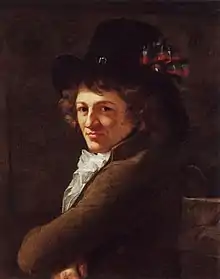Eberhard Georg Friedrich von Wächter
Eberhard Georg Friedrich von Wächter (28 February 1762[1] – 14 August 1852) was a German painter. Wächter died in Stuttgart.
Eberhard von Wächter | |
|---|---|
 Portrait of Wächter by Ludovike Simanowiz, 1791 | |
| Born | Eberhard Georg Friedrich Wächter 28 February 1762 |
| Died | 14 August 1852 (aged 90) |
| Awards | Order of the Crown |

Early life
Wächter was born on 28 February 1762 in Balingen in the Duchy of Württemberg. From an old Württemberg family of civil servants, he was the second son of Chief Magistrate in Balingen and privy councilor, Friedrich Christoph von Wächter (1733–1807) and Sibylle Regine Harpprecht (1737–1793). Among his siblings were diplomat Baron August Heinrich Christoph von Wächter, a Württemberg Legation Councilor who served as chargé d'affaires of Württemberg in The Hague, Brussels, and Frankfurt, and was the father of Baron August von Wächter, who served as Minister of Foreign Affairs of Württemberg. Through his uncle, Eberhard von Wächter, he was related to minister Karl Eberhard von Wächter, president of the High Court of Appeal Carl Georg von Wächter, and minister Karl von Wächter-Spittler.[2]
Career
He studied painting at Paris under Jean-Baptiste Regnault, Jacques-Louis David, and Antoine-Jean, Baron Gros, and later went to Rome, where he improved his French classical style of painting by the study of Italian art. He appreciated Carsten's freer style with its sterling merit, and adopted the ideas of the Romantic school. While at Rome he became a Catholic.
He gained great influence over his contemporaries by his fine perception of the depths of feeling that could be evoked from the subjects he used. To this period of his best work belong a "Child Jesus on the Lamb", "Belisarius at the Porta Pinciana at Rome", and "Job and His Friends". In 1798 the French drove him from Rome, and he went to Vienna, as he found no place in his native town of Stuttgart, on account of his conversion. At Vienna he illustrated books and made drawings, many of which were etched or engraved by Rahl and Leybold. While there he also painted a "Mater dolorosa", a "Caritas", and "Criton visiting Socrates in Prison".
Wachter was a founder of the Brotherhood of St. Luke, a society of those painters who soon after established at Rome a more natural and thoughtful school of painting, known as the Nazarenes. Wachter finally went to Stuttgart, where he painted "Cimon in Prison", "Ulysses and the Sirens", the "Boat of Life", "Andromache standing at the Urn with Hector's Ashes", the "Greek Muse mourning over the Ruins of Athens", a "Virgin with St. John Sorrowing at the Grave of Christ", etc. He excelled in treating lyrical and elegiac subjects.
Honours
1831 Eberhard von Wachter was awarded as Knight of the Order of the Crown (Württemberg),[3] which was associated with the personal title of nobility. The city of Stuttgart named 1873 Wächterstraße and 1902 the guards squadron after him.[4]
References
- [ADB und Brockhaus geben den nicht existierenden 29. Februar 1762 als Geburtsdatum an.]
- Epstein, Klaus (8 March 2015). The Genesis of German Conservatism. Princeton University Press. p. 628. ISBN 978-1-4008-6823-0. Retrieved 28 April 2023.
- [Königlich Württembergisches Hof- und Staatshandbuch 1839, S. 33]
- [Die Stuttgarter Straßennamen, Silberburg Verlag, Tübingen 2. A 2007 ISBN 978-3-87407-748-4]
 This article incorporates text from a publication now in the public domain: Herbermann, Charles, ed. (1913). "Eberhard Wächter". Catholic Encyclopedia. New York: Robert Appleton Company.
This article incorporates text from a publication now in the public domain: Herbermann, Charles, ed. (1913). "Eberhard Wächter". Catholic Encyclopedia. New York: Robert Appleton Company.
Further reading
- Gebhardt, Werner (2011). Die Schüler der Hohen Karlsschule: Ein biographisches Lexikon (in German). Stuttgart: Kohlhammer Verlag. p. 540.
- Vierhaus, Rudolf, ed. (1996). "Wächter, (Georg Friedrich) Eberhard". Deutsche Biographische Enzyklopädie (in German). Vol. 10. Munich: KG Saur Verlag GmbH & Co. KG. p. 271. ISBN 3-598-23163-6.
- Wintterlin, August (1896), "Wächter, Georg Friedrich Eberhard", Allgemeine Deutsche Biographie (ADB) (in German), vol. 40, Leipzig: Duncker & Humblot, pp. 431–434.
- Constantin von Wurzbach: "Wächter, Georg Friedrich Eberhard von." In: Biographisches Lexikon des Kaiserthums Oesterreich (Biographical Lexicon of the Empire of Austria). Part 52 Kaiserlich-königliche Hof- und Staatsdruckerei, Vienna 1885, p. 59 f. (digitalised).
- "von Wächter, Eberhard". Brockhaus Enzyklopädie (in German). Vol. 29 (21 ed.). Mannheim: Bibliographical Institute & FA Brockhaus. 2006. p. 303. ISBN 3-7653-4145-2.
- "Wächter, Eberhard Georg Friedrich". Nordisk familjebok (in Swedish) (2 ed.). 1921.